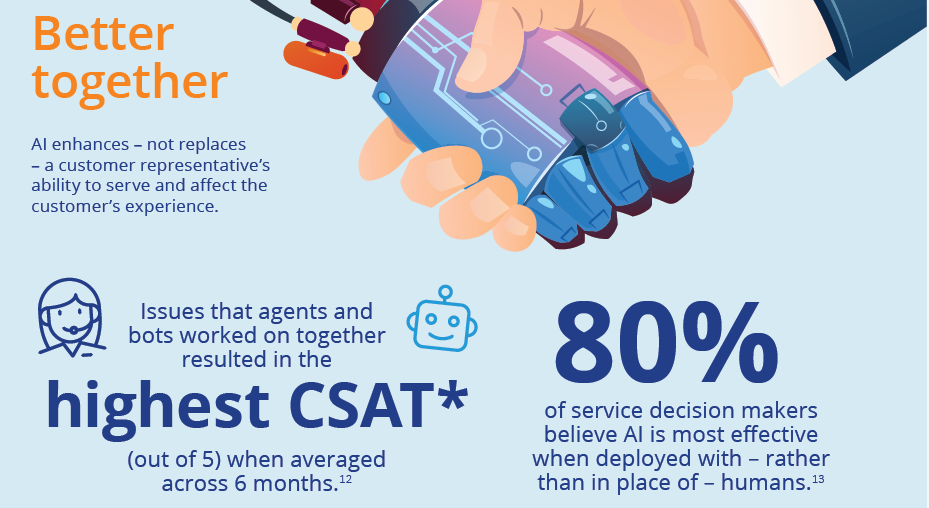Search
Contact Us
AI Makes It Possible (Blog Series)
Access the On-Demand Webinar Playback of “How AI-Enabled Super-Agents Improve CX” with Kate Legget, Vice President and Principal Analyst Service Application Development and Delivery, Forrester Research, with Steve Nattress, Director, R&D and Jacki Tessmer, Vice President – Product Marketing, Enghouse Interactive.
Blog #1 of 4: The Customer Experience.
Customer Perception = Their Reality
What is it? How is it evaluated by your customers – do they think it’s good, bad or are they indifferent?
Why should they care, if you don’t?
 Source: PWC/Bains and Co.
Source: PWC/Bains and Co.
The reality is that “customer experience” is more than a single engagement or interaction with your organization. It starts with a customer’s first point of contact and ends with the last… and increasingly, it goes on afterward as they see or hear from your organization, as you strive to nurture that relationship.
At each interaction, customers are unconsciously assessing your organization and determining if there is value in continuing to do business with you. Each engagement must be a positive experience, quick, seamless, and painless, regardless of the channel or channels they choose to use – voice, SMS, video, email, social media, or any combination thereof.
Netflix and Apple have drastically changed the game for all, triggering ever-changing and ever-increasing customer expectations.
Looking from the outside, inwards
Typically Customer Satisfaction (CSAT) ratings, NPS scores, or customer survey data are viewed as discrete touchpoints, measured at and within each customer interaction.
While many organizations have adopted the use of customer feedback to help better understand customer expectations, but this has not typically resulted in customer experience improvements.
Why? Because that approach is not reflective of the customer’s overall experience. By assessing each touchpoint individually, organizations reduce their ability to view it as part of a cohesive whole.
So, for the organization, there’s more value in holistically analyzing the complete journey, not as a series of discrete interactions.
Understanding what works, and what doesn’t will help the organization identify what needs to be improved, and how. But, keep in mind that this is not a ‘one and done’ scenario. With today’s new realities, everything must be continuously fine-tuned, as customer expectations have become very dynamic. Improve something and that becomes your customer’s new reference standard. Delivering anything less thereafter will most probably lead to instant dissatisfaction and increases the probability of causing customer churn.
 Source: PWC/Bains and Co.
Source: PWC/Bains and Co.
So, how best to improve the customer experience, and then, the business outcomes?
Start by using Automated Conversations – as discussed in our recent self-service blog series, an organization has many options to improve the overall experience. By offering their customers a choice of communication channel, or the use of multiple channels simultaneously, immediately improves the possibility of a positive experience. Remember, for the most part, customers are engaging you because of something not already being properly addressed. Do not add to their frustration by limiting their communications options.
By using professionally recorded messaging with your organization’s IVRs, optimizing your chatbots, and providing unobtrusive ID Authentication systems, along with the integration of your CRM system, you will be able to capture, record and assess what, why and how they have engaged with you. This wealth of information can then be used to improve your organization’s customer service capabilities…minimizing your reliance on costly live agents.
Once that is implemented and optimized, you will need to focus on the other, more complex aspects of your customer experience delivery system.
Add Augmented Conversations – this is where Artificial Intelligence (AI) adds value.
By complementing the information already captured with additional conversational data – whether audio or digital, or an interplay of both combined – and assessing and analyzing the context and keywords used in real-time, organizations can provide increasingly more complex support capabilities directly to the customer, or to the live agent to whom the customer has been transferred.
 [ Click on Image to access the full infographic ]
[ Click on Image to access the full infographic ]
But, there are limitations to consider – most AI-enabled chatbots or Robotic Process Automation (RPA) enabled platforms will try to mimic human interactions, frustrating customers when a misunderstanding arises. A properly configured and implemented conversational AI solution will intuitively (LoL!) know when to trigger a Knowledge Base (KB) search, when to ask the customer for clarification, and determine when best to route customers to a human agent, with enough context to know if a generalist or a specific subject matter expert (SME) would be best.
For these more complex situations, multi-channel conversational AI which leverages Natural Language Processing (NLP), semantic analysis, and industry-specific linguistics, terminologies, phraseologies and other processing, can propose a range of possible solution scenarios to deal with unique or unusual situations and needs.
In summary, viewing the customer journey more holistically ensures that the organization can better understand what meets the customer’s expectations and more importantly what isn’t, enabling the organization to better align their entire enterprise to deliver value to both customers and the business.

Watch for the next blog, coming October 14th:
Understanding Why Helps Transform the Customer Experience
Help make sure your organization delivers the customer experience that exceeds their expectations. Doing so, will transform your contact center from a cost-center into a revenue generator.
Access the On-Demand Webinar Playback of “How AI-Enabled Super-Agents Improve CX” with Kate Legget, Vice President and Principal Analyst Service Application Development and Delivery, Forrester Research, with Steve Nattress, Director, R&D and Jacki Tessmer, Vice President – Product Marketing, Enghouse Interactive.
See how your organization can benefit from Super-Agents
Click Here To View the Playback Now: 
Infographic Sources:
12 https://go.helpshift.com/rs/113-UDX-599/images/Report_State_of_CS_Automation.pdf
13 https://www.zdnet.com/article/ai-is-revolutionizing-customer-service/
Published In
Enghouse Interactive Educates digital transformation Webinar Contact Center Enterprise Contact Center Service Provider Outbound Dialer Partner Programme Communications Center customer support social media webchat CCaaS multi-tenant Unified Communications operator console Nortel call handling quality management Avaya compliance IVR Development Tools Partners Integration & Optimization Service Provider Cloud-Based Contact Center Contact Center Solutions MediaVoice Microsoft Enghouse Interactive IVR/Self-Service ShoreTel Mitel workforce management Cisco zz-General events workforce optimization voice of the customer customer service speech analytics resources BroadSoft training contact center optimization quality monitoring Contact Center Customer Experience Omni-Channel VideoThank you!
You have successfully subscribed to our newsletter.
Sign up here to watch your selected video as well as gain access to the other videos listed here
Sign up here to watch your selected video
Sign up here to watch the videos as well access to more Tips 'N' Tricks videos
Get your free download

